MINI Paceman 2014 Owner's Manual (Mini Connected)
Manufacturer: MINI, Model Year: 2014, Model line: Paceman, Model: MINI Paceman 2014Pages: 282, PDF Size: 6.76 MB
Page 231 of 282
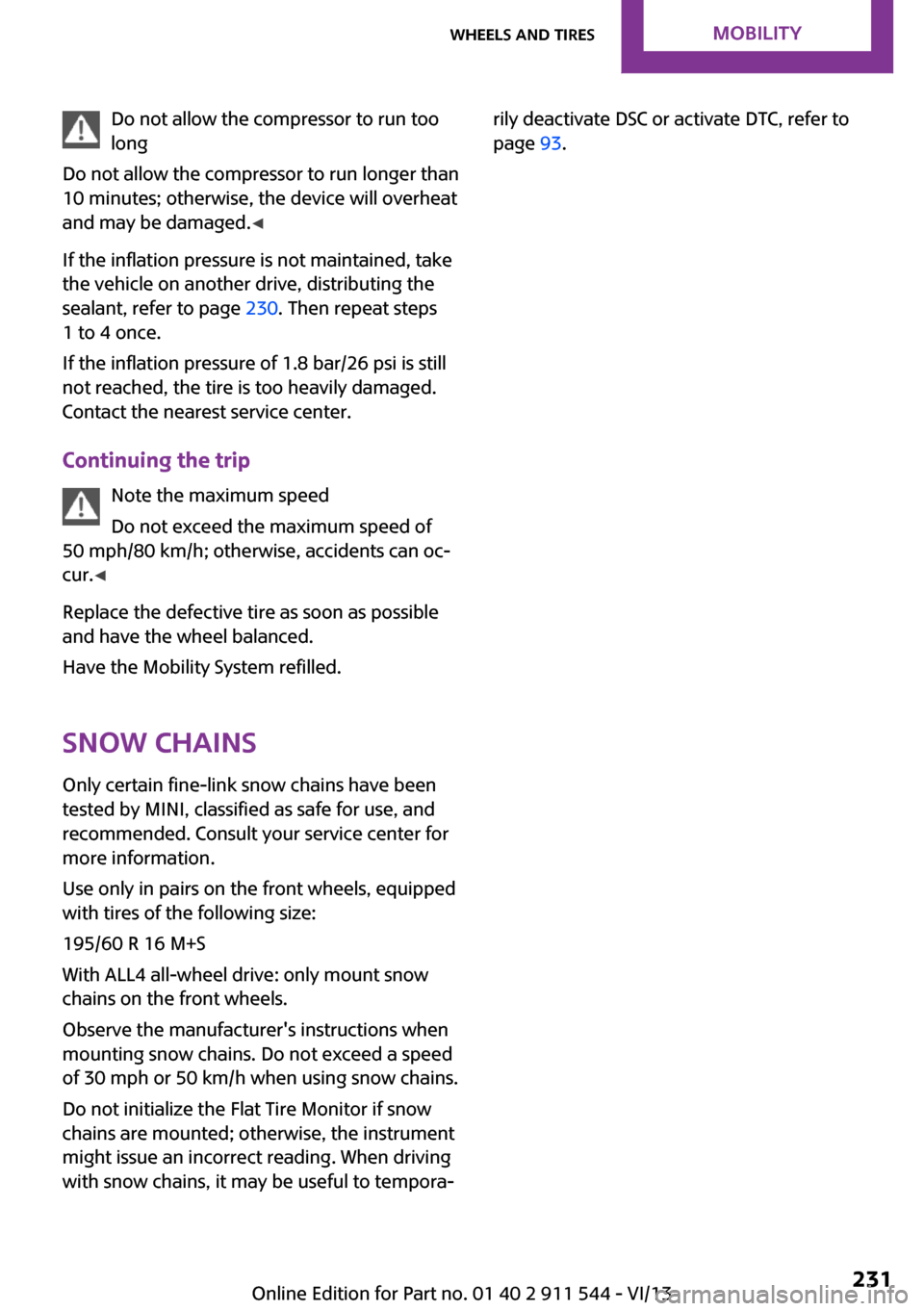
Do not allow the compressor to run too
long
Do not allow the compressor to run longer than
10 minutes; otherwise, the device will overheat
and may be damaged. ‚óÄ
If the inflation pressure is not maintained, take
the vehicle on another drive, distributing the
sealant, refer to page 230. Then repeat steps
1 to 4 once.
If the inflation pressure of 1.8 bar/26 psi is still
not reached, the tire is too heavily damaged.
Contact the nearest service center.
Continuing the trip Note the maximum speed
Do not exceed the maximum speed of
50 mph/80 km/h; otherwise, accidents can oc‚Äź
cur. ‚óÄ
Replace the defective tire as soon as possible
and have the wheel balanced.
Have the Mobility System refilled.
Snow chains
Only certain fine-link snow chains have been
tested by MINI, classified as safe for use, and
recommended. Consult your service center for more information.
Use only in pairs on the front wheels, equipped
with tires of the following size:
195/60 R 16 M+S
With ALL4 all-wheel drive: only mount snow
chains on the front wheels.
Observe the manufacturer's instructions when
mounting snow chains. Do not exceed a speed
of 30 mph or 50 km/h when using snow chains.
Do not initialize the Flat Tire Monitor if snow
chains are mounted; otherwise, the instrument
might issue an incorrect reading. When driving
with snow chains, it may be useful to tempora‚Äźrily deactivate DSC or activate DTC, refer to
page 93.Seite 231Wheels and tiresMobility231
Online Edition for Part no. 01 40 2 911 544 - VI/13
Page 232 of 282
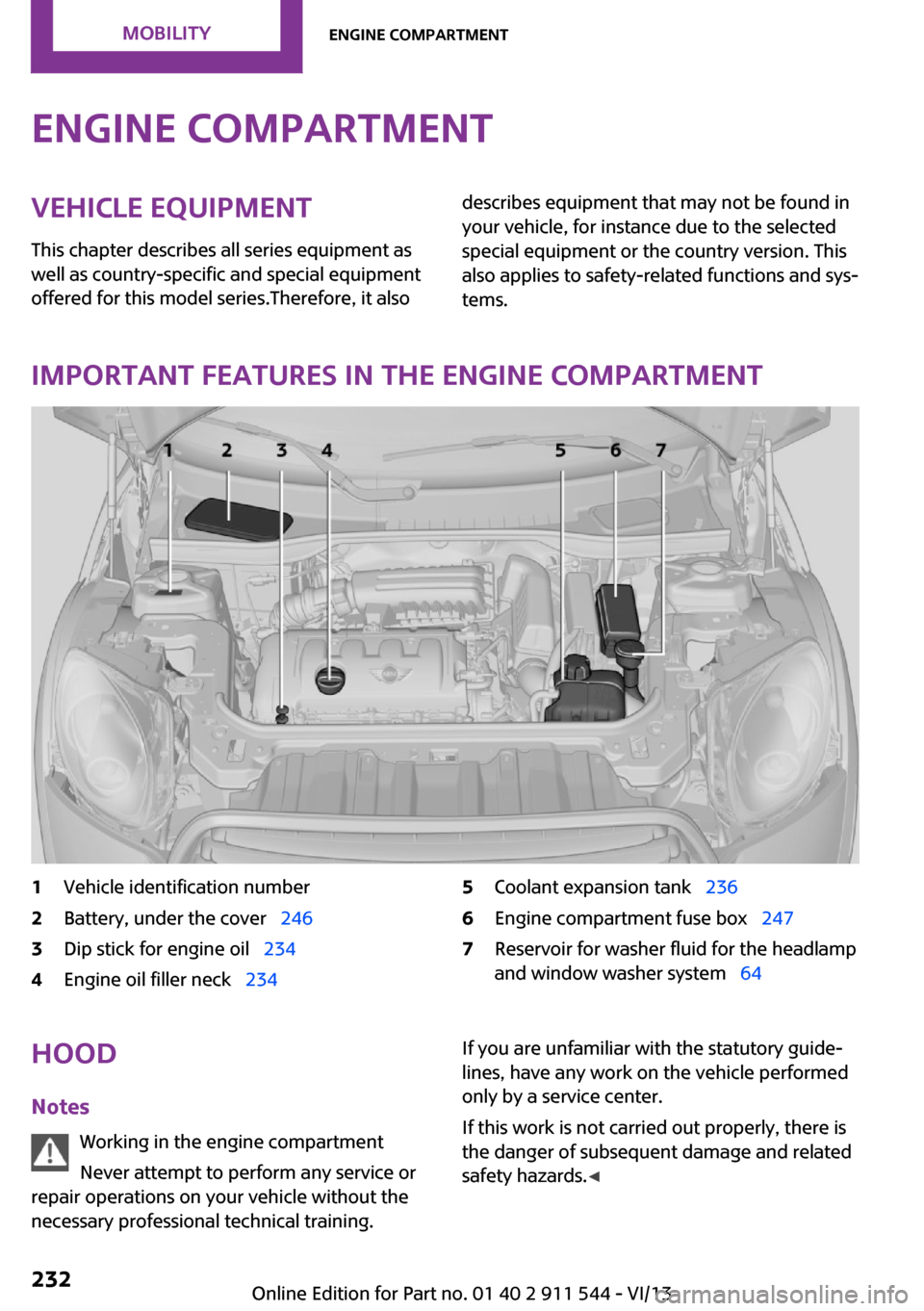
Engine compartmentVehicle equipment
This chapter describes all series equipment as
well as country-specific and special equipment
offered for this model series.Therefore, it alsodescribes equipment that may not be found in
your vehicle, for instance due to the selected
special equipment or the country version. This
also applies to safety-related functions and sys‚Äź
tems.
Important features in the engine compartment
1Vehicle identification number2Battery, under the cover‚Äā‚ÄÖ 2463Dip stick for engine oil‚Äā‚ÄÖ2344Engine oil filler neck‚Äā‚ÄÖ2345Coolant expansion tank‚Äā‚ÄÖ 2366Engine compartment fuse box‚Äā‚ÄÖ 2477Reservoir for washer fluid for the headlamp
and window washer system‚Äā‚ÄÖ 64Hood
Notes Working in the engine compartment
Never attempt to perform any service or
repair operations on your vehicle without the
necessary professional technical training.If you are unfamiliar with the statutory guide‚Äź
lines, have any work on the vehicle performed
only by a service center.
If this work is not carried out properly, there is
the danger of subsequent damage and related
safety hazards. ‚óÄSeite 232MobilityEngine compartment232
Online Edition for Part no. 01 40 2 911 544 - VI/13
Page 233 of 282

To avoid damage, make sure that the
wiper arms are resting against the wind‚Äź
shield before you open the engine compart‚Äź
ment. Do not open the engine hood before the
engine has cooled down; otherwise, injuries
may result. ‚óÄ
Unlocking and opening the hood1.Pull the lever.2.Lift the hood all the way.3.Press the release handle and open the
hood.
Danger of injury when the hood is open
There is a danger of injury from protrud‚Äź
ing parts when the hood is open. ‚óÄ
Closing the hood
Close the hood from a height of ap‚Äź
prox. 16 in/40 cm with momentum. It must be
clearly heard to engage.
Hood open when driving
If you see any signs that the hood is not
completely closed while driving, pull over im‚Äź
mediately and close it securely. ‚óÄ
Danger of pinching
Make sure that the closing path of the
hood is clear; otherwise, injuries may result. ‚óÄ
Seite 233Engine compartmentMobility233
Online Edition for Part no. 01 40 2 911 544 - VI/13
Page 234 of 282

Engine oilVehicle equipment
This chapter describes all series equipment as
well as country-specific and special equipment
offered for this model series.Therefore, it also
describes equipment that may not be found in
your vehicle, for instance due to the selected
special equipment or the country version. This
also applies to safety-related functions and sys‚Äź
tems.
Engine oil General information
Engine oil consumption depends on the driving
style and the conditions of use. A highly sporty
driving style, for example, results in considera‚Äź
bly higher engine oil consumption.
Therefore, regularly check the engine oil level
after refueling.
Checking the oil level with a dip stick1.Park the vehicle on level ground when the
engine is at operating temperature, i.e., af‚Äź
ter driving continuously for at least
6 2 miles/10 km.2.Switch the engine off.3.After approx. 5 minutes, pull out the dip
stick and wipe it off with a lint-free cloth,
paper towel, etc.4.Carefully insert the dip stick all the way into
the measuring tube and pull it out again.The oil level must be between the two
marks on the dip stick.
The oil quantity between the two marks on the
dip stick equals approx. 1 US quart/1 liter.
Do not exceed the high mark.
Do not exceed the high mark of the dip
stick. Overfilling oil damages the engine. ‚óÄ
Adding engine oil
Filler neck
Add a maximum quantity of 1 US quart/1 liter
of oil only after the corresponding message ap‚Äź
pears on the Control Display or, in diesel en‚Äź
gines, after the oil level is just above the low
mark of the dip stick, refer to page 234.
Add oil promptly
Add oil within the next 30 miles/50 km;
otherwise, engine damage could result. ‚óÄ
Seite 234MobilityEngine oil234
Online Edition for Part no. 01 40 2 911 544 - VI/13
Page 235 of 282
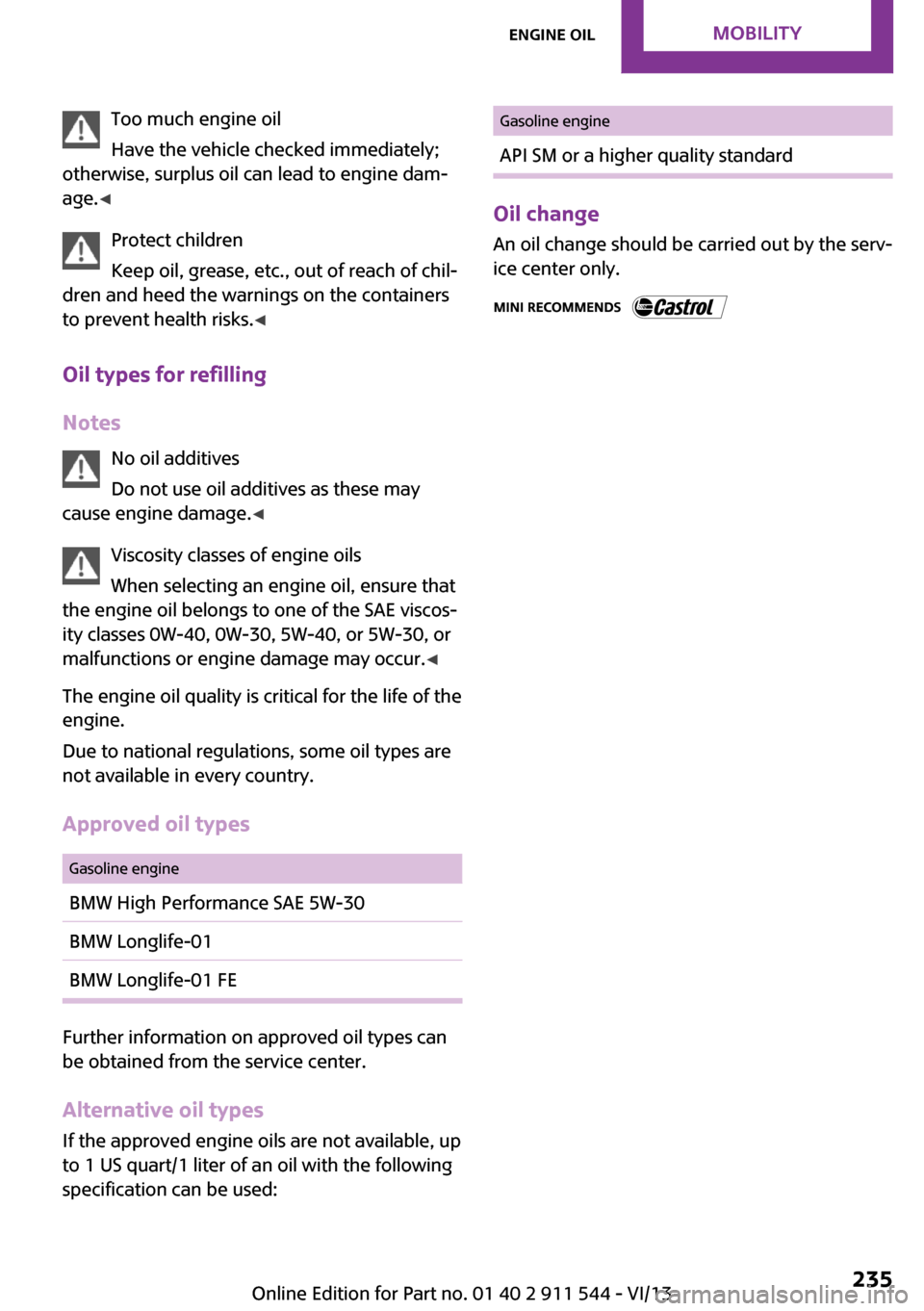
Too much engine oil
Have the vehicle checked immediately;
otherwise, surplus oil can lead to engine dam‚Äź
age. ‚óÄ
Protect children
Keep oil, grease, etc., out of reach of chil‚Äź
dren and heed the warnings on the containers
to prevent health risks. ‚óÄ
Oil types for refilling
Notes No oil additives
Do not use oil additives as these may
cause engine damage. ‚óÄ
Viscosity classes of engine oils
When selecting an engine oil, ensure that
the engine oil belongs to one of the SAE viscos‚Äź
ity classes 0W-40, 0W-30, 5W-40, or 5W-30, or
malfunctions or engine damage may occur. ‚óÄ
The engine oil quality is critical for the life of the
engine.
Due to national regulations, some oil types are
not available in every country.
Approved oil typesGasoline engineBMW High Performance SAE 5W-30BMW Longlife-01BMW Longlife-01 FE
Further information on approved oil types can
be obtained from the service center.
Alternative oil types
If the approved engine oils are not available, up
to 1 US quart/1 liter of an oil with the following
specification can be used:
Gasoline engineAPI SM or a higher quality standard
Oil change
An oil change should be carried out by the serv‚Äź
ice center only.
Seite 235Engine oilMobility235
Online Edition for Part no. 01 40 2 911 544 - VI/13
Page 236 of 282
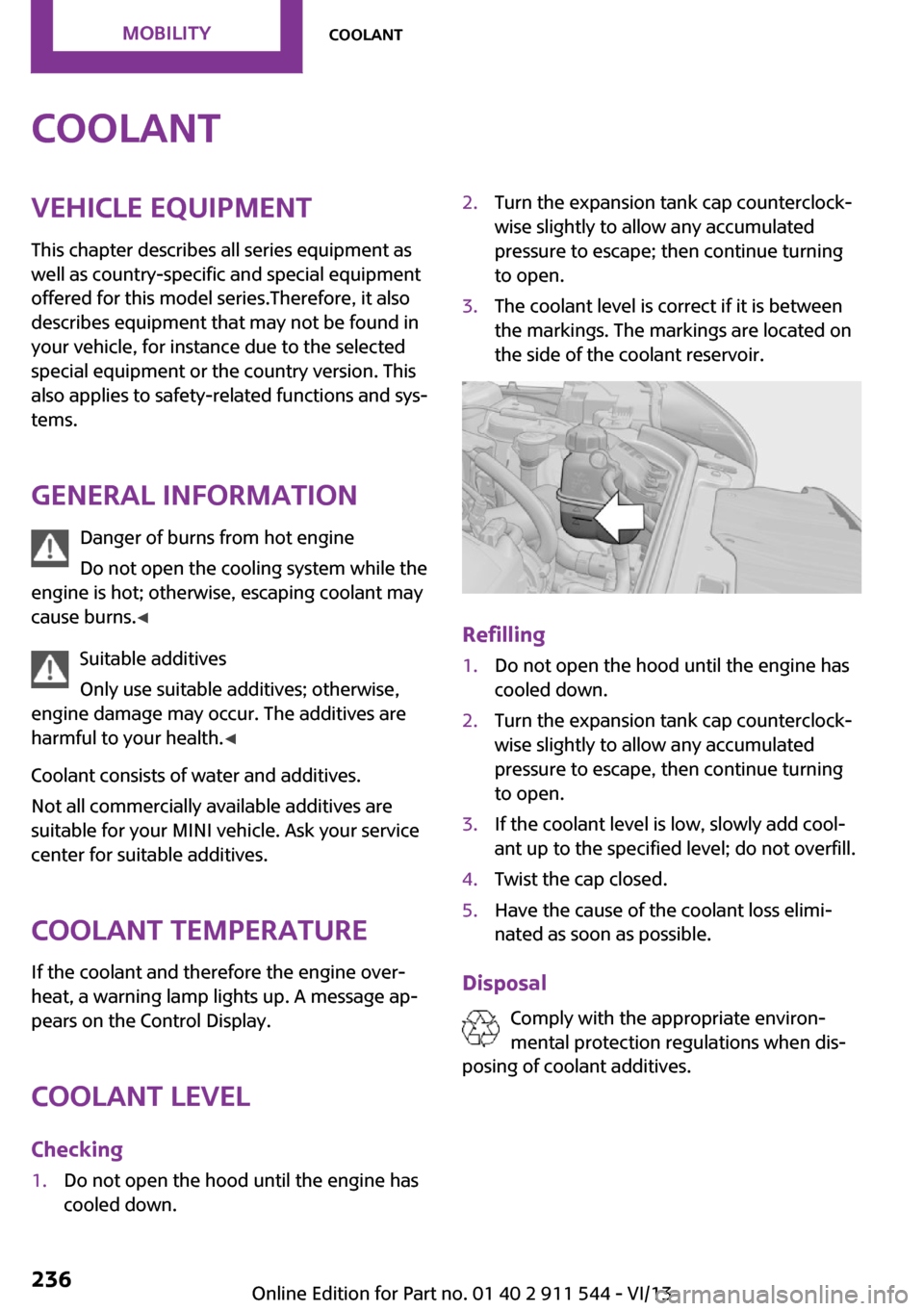
CoolantVehicle equipment
This chapter describes all series equipment as
well as country-specific and special equipment
offered for this model series.Therefore, it also
describes equipment that may not be found in
your vehicle, for instance due to the selected
special equipment or the country version. This
also applies to safety-related functions and sys‚Äź
tems.
General information Danger of burns from hot engine
Do not open the cooling system while the
engine is hot; otherwise, escaping coolant may
cause burns. ‚óÄ
Suitable additives
Only use suitable additives; otherwise,
engine damage may occur. The additives are
harmful to your health. ‚óÄ
Coolant consists of water and additives.
Not all commercially available additives are
suitable for your MINI vehicle. Ask your service
center for suitable additives.
Coolant temperature
If the coolant and therefore the engine over‚Äź
heat, a warning lamp lights up. A message ap‚Äź
pears on the Control Display.
Coolant level Checking1.Do not open the hood until the engine has
cooled down.2.Turn the expansion tank cap counterclock‚Äź
wise slightly to allow any accumulated
pressure to escape; then continue turning
to open.3.The coolant level is correct if it is between
the markings. The markings are located on
the side of the coolant reservoir.
Refilling
1.Do not open the hood until the engine has
cooled down.2.Turn the expansion tank cap counterclock‚Äź
wise slightly to allow any accumulated
pressure to escape, then continue turning
to open.3.If the coolant level is low, slowly add cool‚Äź
ant up to the specified level; do not overfill.4.Twist the cap closed.5.Have the cause of the coolant loss elimi‚Äź
nated as soon as possible.
Disposal
Comply with the appropriate environ‚Äźmental protection regulations when dis‚Äź
posing of coolant additives.
Seite 236MobilityCoolant236
Online Edition for Part no. 01 40 2 911 544 - VI/13
Page 237 of 282
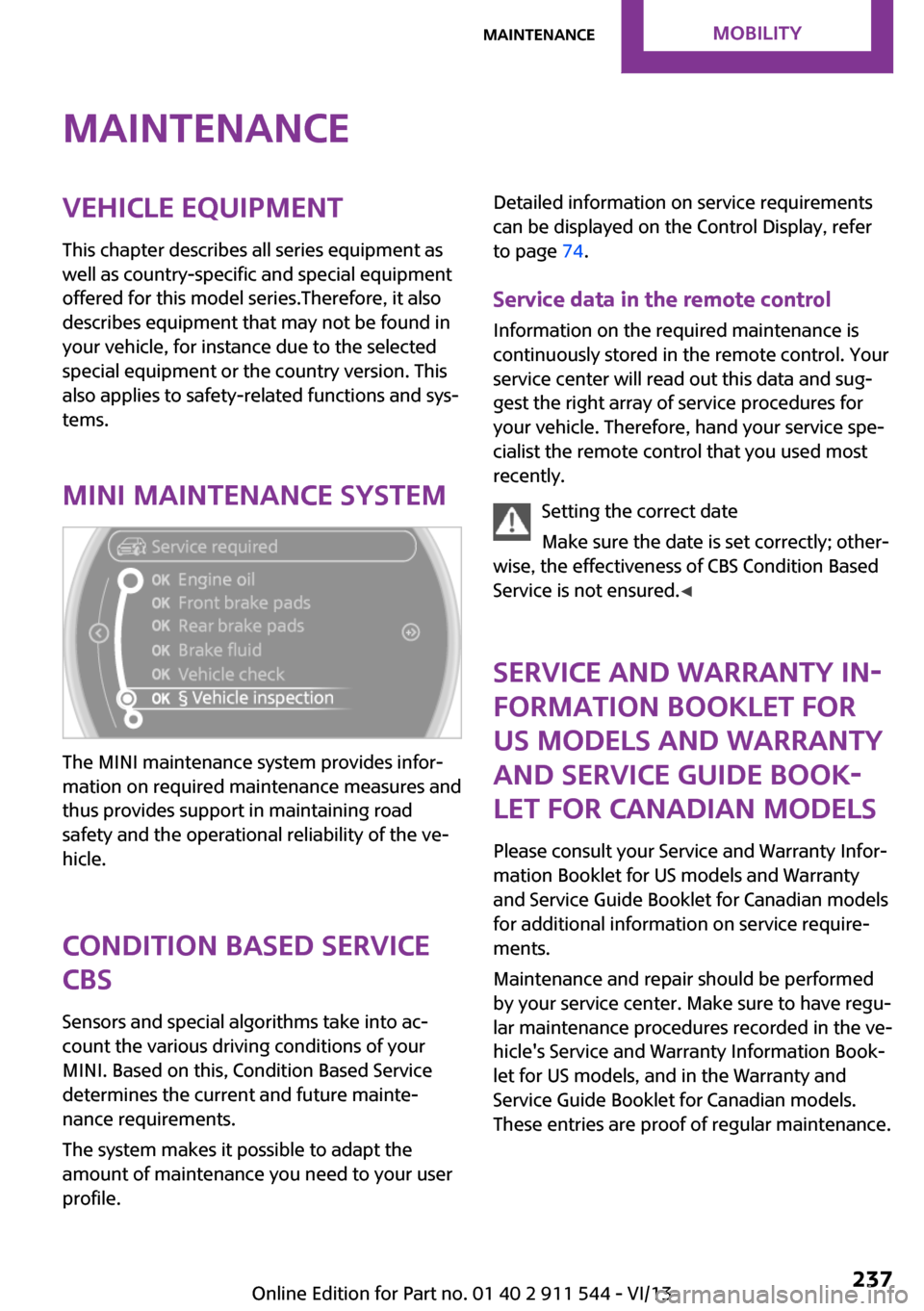
MaintenanceVehicle equipment
This chapter describes all series equipment as
well as country-specific and special equipment
offered for this model series.Therefore, it also
describes equipment that may not be found in
your vehicle, for instance due to the selected
special equipment or the country version. This
also applies to safety-related functions and sys‚Äź
tems.
MINI maintenance system
The MINI maintenance system provides infor‚Äź
mation on required maintenance measures and
thus provides support in maintaining road
safety and the operational reliability of the ve‚Äź
hicle.
Condition Based Service
CBS
Sensors and special algorithms take into ac‚Äź
count the various driving conditions of your
MINI. Based on this, Condition Based Service
determines the current and future mainte‚Äź
nance requirements.
The system makes it possible to adapt the
amount of maintenance you need to your user
profile.
Detailed information on service requirements
can be displayed on the Control Display, refer
to page 74.
Service data in the remote control
Information on the required maintenance is continuously stored in the remote control. Your
service center will read out this data and sug‚Äź
gest the right array of service procedures for
your vehicle. Therefore, hand your service spe‚Äź
cialist the remote control that you used most
recently.
Setting the correct date
Make sure the date is set correctly; other‚Äź
wise, the effectiveness of CBS Condition Based
Service is not ensured. ‚óÄ
Service and Warranty In‚Äź
formation Booklet for
US models and Warranty and Service Guide Book‚Äź
let for Canadian models
Please consult your Service and Warranty Infor‚Äź
mation Booklet for US models and Warranty
and Service Guide Booklet for Canadian models
for additional information on service require‚Äź
ments.
Maintenance and repair should be performed
by your service center. Make sure to have regu‚Äź
lar maintenance procedures recorded in the ve‚Äź
hicle's Service and Warranty Information Book‚Äź
let for US models, and in the Warranty and
Service Guide Booklet for Canadian models.
These entries are proof of regular maintenance.Seite 237MaintenanceMobility237
Online Edition for Part no. 01 40 2 911 544 - VI/13
Page 238 of 282

Socket for OBD Onboard
Diagnosis
Socket for Onboard Diagnosis
The socket for Onboard Diagnosis may
only be used by the service center, by work‚Äź
shops that operate according to the specifica‚Äź
tions of the vehicle manufacturer with appro‚Äź
priately trained personnel, and by other
authorized persons. Otherwise, its use may
lead to vehicle malfunctions. ‚óÄ
Primary components in the vehicle emissions
can be checked via the OBD socket using a de‚Äź
vice.
Emissions The warning lamps light up. The vehicle
is producing higher emissions. You can
continue your journey, but moderate
your speed and exercise due caution. Have the
vehicle checked as soon as possible.
Under certain circumstances, one of the lamps
flashes or lights up continuously. This indicates
that there is excessive misfiring or a malfunc‚Äź
tion in the engine. If this happens, reduce the
vehicle speed and drive to the next service cen‚Äź
ter promptly. Serious engine misfiring within a
brief period can seriously damage emission
control components, in particular the catalytic
converter. In addition, the mechanical engine
components may become damaged.
If the fuel filler cap is not properly tight‚Äź
ened, the OBD system may conclude
that fuel vapor is escaping; this will cause a dis‚Äź
play to light up. If the filler cap is then tight‚Äź
ened, the display should go out in a few days.Seite 238MobilityMaintenance238
Online Edition for Part no. 01 40 2 911 544 - VI/13
Page 239 of 282
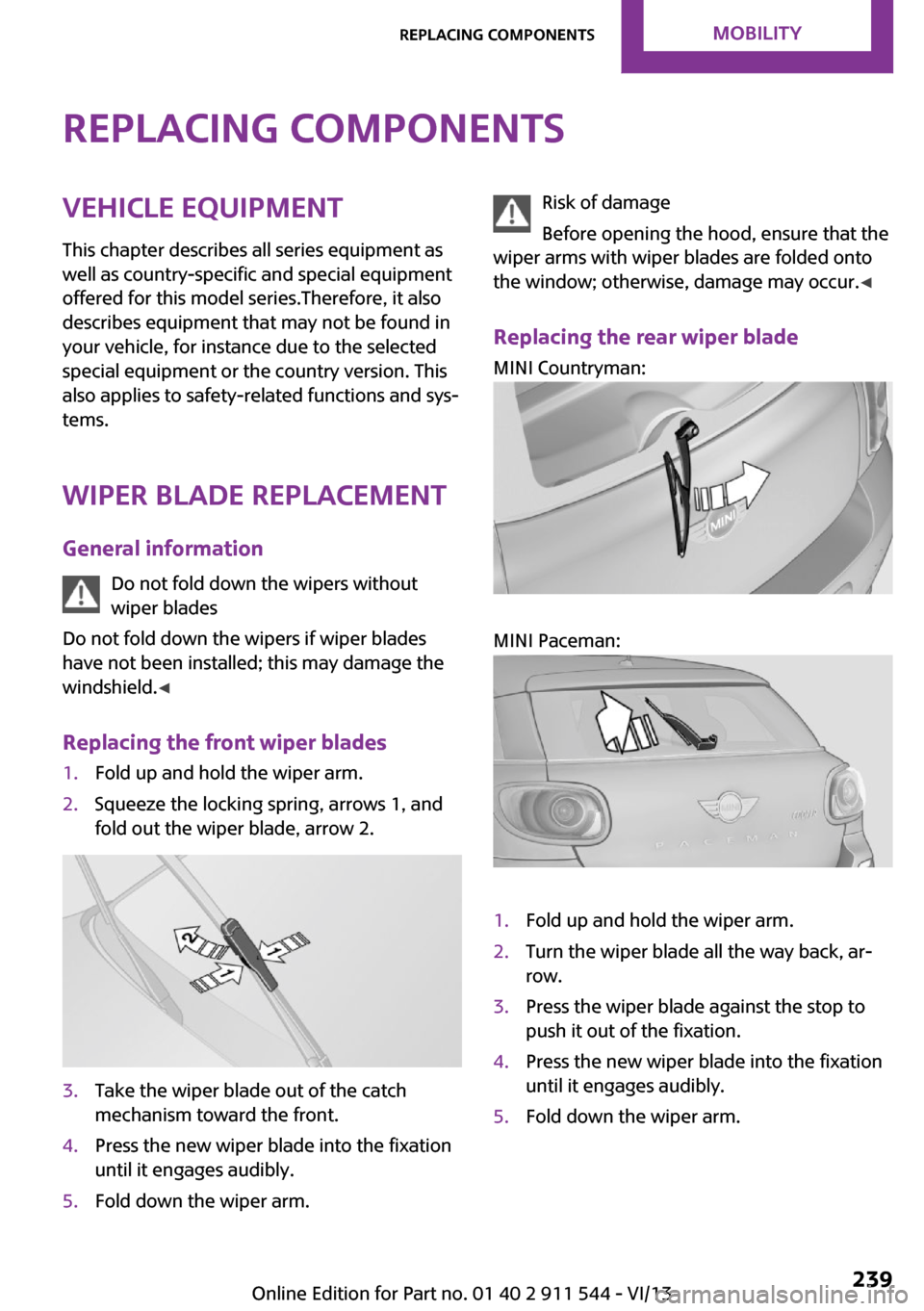
Replacing componentsVehicle equipmentThis chapter describes all series equipment as
well as country-specific and special equipment
offered for this model series.Therefore, it also
describes equipment that may not be found in
your vehicle, for instance due to the selected
special equipment or the country version. This
also applies to safety-related functions and sys‚Äź
tems.
Wiper blade replacement General information Do not fold down the wipers without
wiper blades
Do not fold down the wipers if wiper blades
have not been installed; this may damage the
windshield. ‚óÄ
Replacing the front wiper blades1.Fold up and hold the wiper arm.2.Squeeze the locking spring, arrows 1, and
fold out the wiper blade, arrow 2.3.Take the wiper blade out of the catch
mechanism toward the front.4.Press the new wiper blade into the fixation
until it engages audibly.5.Fold down the wiper arm.Risk of damage
Before opening the hood, ensure that the
wiper arms with wiper blades are folded onto
the window; otherwise, damage may occur. ‚óÄ
Replacing the rear wiper blade
MINI Countryman:
MINI Paceman:
1.Fold up and hold the wiper arm.2.Turn the wiper blade all the way back, ar‚Äź
row.3.Press the wiper blade against the stop to
push it out of the fixation.4.Press the new wiper blade into the fixation
until it engages audibly.5.Fold down the wiper arm.Seite 239Replacing componentsMobility239
Online Edition for Part no. 01 40 2 911 544 - VI/13
Page 240 of 282
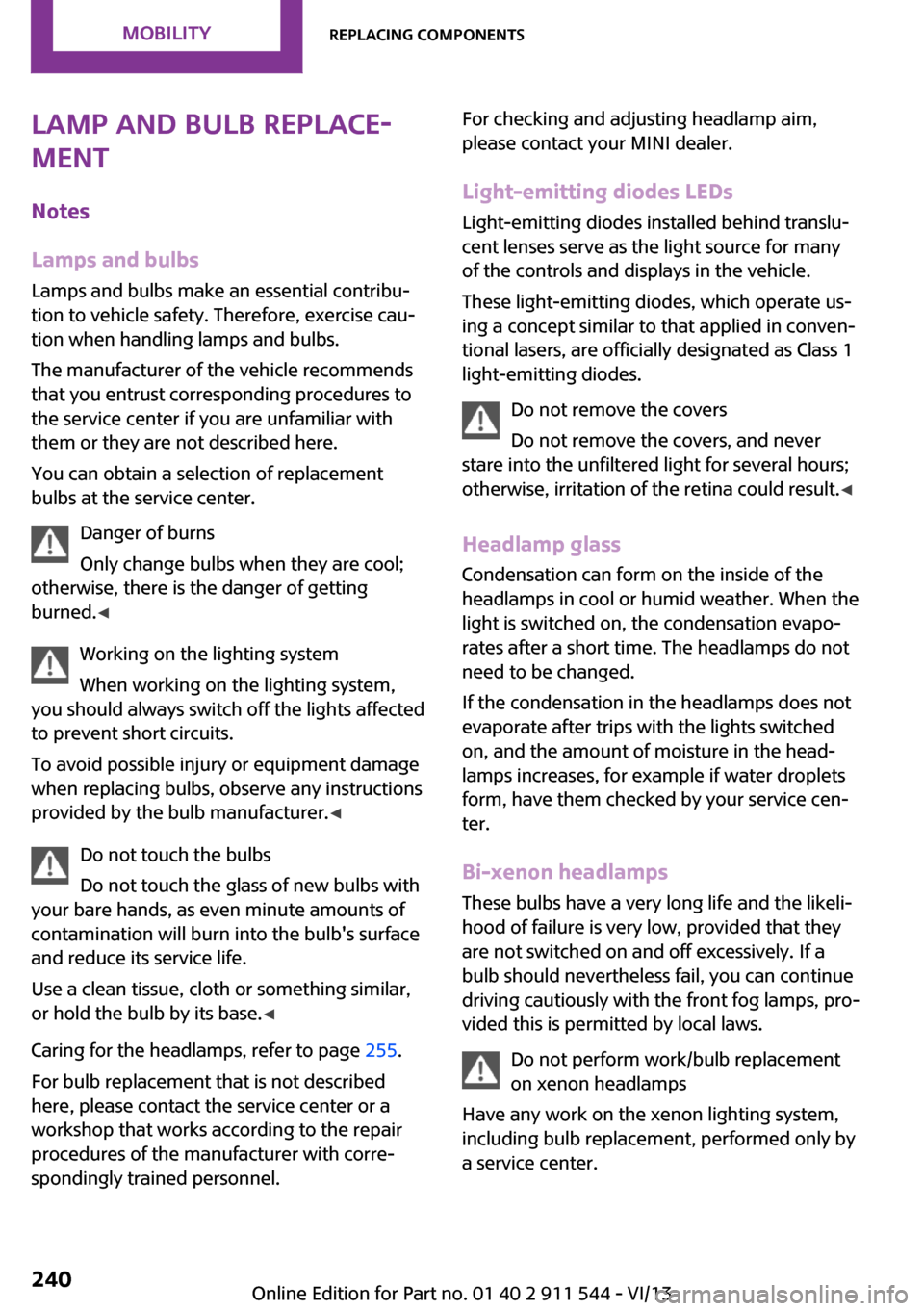
Lamp and bulb replace‚Äź
ment
Notes
Lamps and bulbs Lamps and bulbs make an essential contribu‚Äź
tion to vehicle safety. Therefore, exercise cau‚Äź
tion when handling lamps and bulbs.
The manufacturer of the vehicle recommends
that you entrust corresponding procedures to
the service center if you are unfamiliar with
them or they are not described here.
You can obtain a selection of replacement
bulbs at the service center.
Danger of burns
Only change bulbs when they are cool;
otherwise, there is the danger of getting
burned. ‚óÄ
Working on the lighting system
When working on the lighting system,
you should always switch off the lights affected
to prevent short circuits.
To avoid possible injury or equipment damage
when replacing bulbs, observe any instructions
provided by the bulb manufacturer. ‚óÄ
Do not touch the bulbs
Do not touch the glass of new bulbs with
your bare hands, as even minute amounts of
contamination will burn into the bulb's surface
and reduce its service life.
Use a clean tissue, cloth or something similar,
or hold the bulb by its base. ‚óÄ
Caring for the headlamps, refer to page 255.
For bulb replacement that is not described
here, please contact the service center or a
workshop that works according to the repair
procedures of the manufacturer with corre‚Äź
spondingly trained personnel.For checking and adjusting headlamp aim,
please contact your MINI dealer.
Light-emitting diodes LEDs Light-emitting diodes installed behind translu‚Äź
cent lenses serve as the light source for many
of the controls and displays in the vehicle.
These light-emitting diodes, which operate us‚Äź
ing a concept similar to that applied in conven‚Äź
tional lasers, are officially designated as Class 1
light-emitting diodes.
Do not remove the covers
Do not remove the covers, and never
stare into the unfiltered light for several hours;
otherwise, irritation of the retina could result. ‚óÄ
Headlamp glass
Condensation can form on the inside of the
headlamps in cool or humid weather. When the
light is switched on, the condensation evapo‚Äź rates after a short time. The headlamps do notneed to be changed.
If the condensation in the headlamps does not
evaporate after trips with the lights switched
on, and the amount of moisture in the head‚Äź
lamps increases, for example if water droplets
form, have them checked by your service cen‚Äź
ter.
Bi-xenon headlamps These bulbs have a very long life and the likeli‚Äź
hood of failure is very low, provided that they
are not switched on and off excessively. If a
bulb should nevertheless fail, you can continue
driving cautiously with the front fog lamps, pro‚Äź
vided this is permitted by local laws.
Do not perform work/bulb replacement
on xenon headlamps
Have any work on the xenon lighting system,
including bulb replacement, performed only by
a service center.Seite 240MobilityReplacing components240
Online Edition for Part no. 01 40 2 911 544 - VI/13